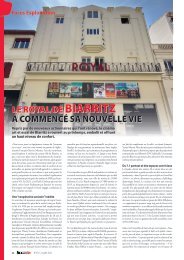Boxoffice-July.01/1950
You also want an ePaper? Increase the reach of your titles
YUMPU automatically turns print PDFs into web optimized ePapers that Google loves.
—<br />
><br />
and with none of the overpowering Moorish<br />
motifs of the 1920s. Light colors are<br />
chosen by most interior designers for their<br />
feeUng of gaiety and glamor—qualities more<br />
necessary in a theatre than anywhere else.<br />
Asphalt tile is a friendly flooring, easy<br />
on the eyes and feet, and is installed tileby-tile,<br />
which permits the creation of a<br />
wide variety of designs in beautiful colors.<br />
Colors favored by outstanding industrial<br />
color consultants include Kentile colors<br />
named after famous Greek, Italian and<br />
French marbles which they closely resemble.<br />
They suggest luxury and proper<br />
theatre atmosphere and have names like<br />
"Greek Skyros," "Istrian," "Cippolino,"<br />
and "Languedoc."<br />
The red-brown marbleized Languedoc<br />
serves a very practical purpose in the<br />
theatre lobby because it tends to camouflage<br />
tracked-in dirt or muddy spots.<br />
Greek Skyros serves the same purpose<br />
when a beige marbleized design is desired;<br />
Istrian has the same effect in a creamcolored<br />
marble; and Cippolino in a green<br />
marbleized shade.<br />
These colorful classic designs are ideally<br />
suited for such areas as the mezzanine<br />
parapet, balcony and terrace. They blend<br />
with any interior, and diagonal striped<br />
patterns can be employed to give narrow<br />
mezzanine and balcony floors a more spacious<br />
effect.<br />
Theatre planners and designers often<br />
suggest Themetile, Kenserts and feature<br />
strip for originality in design. These are<br />
ready-made in a wide selection of patterns<br />
and contrasting colors—musical notes and<br />
other symbols appropriate for a theatre.<br />
Numerals and letters can be used to insert<br />
the theatre's name or slogan for added<br />
Individuality at the entrance, center of the<br />
lobby, center aisle, or other points.<br />
For the theatre with lounges and washrooms<br />
located in the basement, architects<br />
are almost unanimous in specifying asphalt<br />
tile as the preferred smooth -surfaced, resilient<br />
flooring because it is not damaged<br />
by moisture and alkali which rises through<br />
concrete.<br />
One of the most important functions of<br />
theatre flooring is to protect the patron<br />
from falls. Slipping and falling is a hazard<br />
which theatre operators can minimize<br />
through selection of the proper flooring.<br />
The safety factor is a leading reason<br />
why architects today are specifying asphalt<br />
tile for theatres. The National Bureau of<br />
Standards has conducted exhaustive tests<br />
and has found that asphalt tile has generally<br />
the highest anti-slip coefficient of<br />
all smooth-surfaced flooring materials<br />
meaning there is less danger of slipping<br />
on this type of flooring, provided overwaxing<br />
is avoided.<br />
A safe flooring that helps to prevent<br />
falls and other types of bodily injury also<br />
helps to keep public liability insurance<br />
rates at a lower level and cuts the cost of<br />
theatre overhead.<br />
With greater insistence on fire-safety in<br />
theatres today, the fact that asphalt tile<br />
Rubber tile, though somewhat more expensive, makes a durable and lovely floor for lounges<br />
or foyers either. Shown above is a floor machine being used to scrub a rubber tiled floor. Such<br />
maintenance is simple and will prolong both life and beauty. —Photo courtesy S C Johnson & Son<br />
contains a large amount of asbestos has<br />
brought it recognition as a fire-resistant<br />
material. Burning matches or cigarets<br />
leave no permanent marks on it.<br />
This flooring can take the punishment<br />
of heavy theatre traffic because it is tough,<br />
is made of super-durable materials, is resilient<br />
and yields to pressure instead of<br />
abrading. With it there are no worn traffic<br />
lanes or beaten paths in the aisles or other<br />
main corridors to contend with. The colors<br />
can't walk off, because they go right<br />
through to the back of the tile.<br />
In case of damage by accident or abuse,<br />
individual tiles may be easily replaced<br />
without affecting the appearance of the<br />
floor: and alterations or extensions can<br />
be made, using colors originally installed,<br />
without unsightly patching.<br />
Asphalt tile can be installed over almost<br />
any type of subfloor, such as wood, metal.<br />
or concrete, and can be employed either on<br />
grade or below grade level.<br />
Muddy feet and tracked-in dirt constitute<br />
no problem in the theatre with floors<br />
of asphalt tile. Wet footprints can be wiped<br />
up with a damp mop. Dust and dirt won't<br />
stick to its smooth surface. Routine sweeping<br />
and an occasional washing and waxing<br />
are all the care required to maintain<br />
its freshness. Cigaret burns are easily removed<br />
with a steel wool buffing. Low<br />
cost, easy maintenance make asphalt tile<br />
doubly desirable in theatres because the<br />
cost per year of service is lower than that<br />
of any other type of resilient<br />
flooring.<br />
It is necessary to shut down a theatre<br />
for a short time only while asphalt tile is<br />
being laid, as it can be walked on immediately<br />
after laying. In the event of general<br />
theatre alterations, replacement is<br />
simple and inexpensive.<br />
All of these features make asphalt tile<br />
a logical choice when planning a flooring<br />
for a new theatre or when modernizing an<br />
old one.<br />
Rubber tile floors help to cushion footsteps<br />
and provide an extremely silent flooring<br />
underfoot. This is an important asset<br />
to any theatre, where silence contributes<br />
so much to the patrons' enjoyment of the<br />
evening's program. It deadens the noise<br />
of footsteps reflecting little or no more<br />
sound than the average carpeted floor.<br />
Rubber tile is excellent for mezzanines,<br />
and orchestra aisles and other corridors<br />
where extreme quiet is desirable. It comes<br />
in a variety of colorful patterns and designs<br />
that are easily adapted to the decor<br />
of almost any theatre interior.<br />
It has a non-porous surface, does not<br />
warp or buckle. It can be installed over<br />
almost any smooth, dry, hard surface,<br />
wood or concrete. Rubber tile is a costlier<br />
flooring than asphalt tile.<br />
Rubber tile is one of the easiest floors<br />
to maintain and keep clean. Newly installed<br />
rubber tile should stand for a few<br />
days to allow the cement to set before<br />
the floor is polished. After that, a swish<br />
of a damp mop keeps it gleaming and<br />
lustrous.<br />
The fact that the smooth, bright<br />
surface needs very little waxing helps to<br />
cut maintenance costs.<br />
CORK TILE<br />
For distinctive executive offices, powder<br />
rooms and other areas where an atmosphere<br />
of luxury is desired, a cork tile floor<br />
(Continued on page 18<br />
BOXOFFICE July 1, <strong>1950</strong>

















